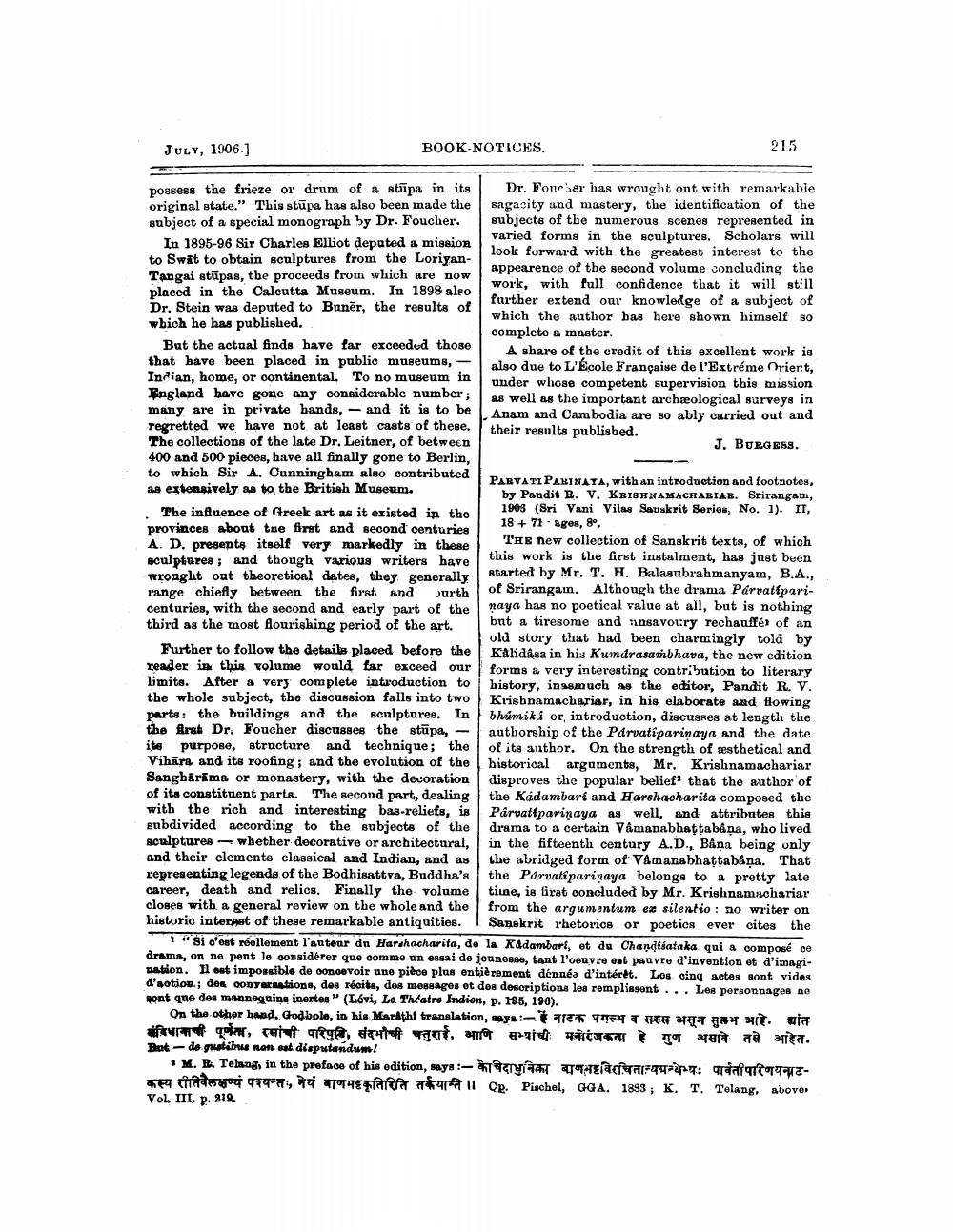________________
JULY, 1906.]
BOOK-NOTICES.
possess the frieze or drum of a stupa in its original state." This stupa has also been made the subject of a special monograph by Dr. Foucher.
In 1895-96 Sir Charles Elliot deputed a mission to Swat to obtain sculptures from the LoriyanTangai stupas, the proceeds from which are now placed in the Calcutta Museum. In 1898 also Dr. Stein was deputed to Buner, the results of which he has published.
But the actual finds have far exceeded those that have been placed in public museums, Indian, home, or continental. To no museum in England have gone any considerable number; many are in private hands, and it is to be regretted we have not at least casts of these. The collections of the late Dr. Leitner, of between 400 and 500 pieces, have all finally gone to Berlin, to which Sir A. Cunningham also contributed as extensively as to the British Museum.
-
The influence of Greek art as it existed in the provinces about tue first and second centuries A. D. presents itself very markedly in these sculptures; and though various writers have wronght out theoretical dates, they generally range chiefly between the first and Jurth centuries, with the second and early part of the third as the most flourishing period of the art.
Further to follow the details placed before the reader in this volume would far exceed our limits. After a very complete introduction to the whole subject, the discussion falls into two parts: the buildings and the sculptures. In the first Dr. Foucher discusses the stupa, its purpose, structure and technique; the Vihara and its roofing; and the evolution of the Sangharima or monastery, with the decoration of its constituent parts. The second part, dealing with the rich and interesting bas-reliefs, is subdivided according to the subjects of the sculptures whether decorative or architectural, and their elements classical and Indian, and as representing legends of the Bodhisattva, Buddha's career, death and relics. Finally the volume closes with a general review on the whole and the historic interest of these remarkable antiquities.
215
Dr. Foneer has wrought out with remarkable sagacity and mastery, the identification of the subjects of the numerous scenes represented in varied forms in the sculptures. Scholars will look forward with the greatest interest to the appearence of the second volume concluding the work, with full confidence that it will still further extend our knowledge of a subject of which the author has here shown himself so complete a master.
A share of the credit of this excellent work is
also due to L'École Française de l'Extréme Oriert, under whose competent supervision this mission as well as the important archaeological surveys in Anam and Cambodia are so ably carried out and their results published.
J. BURGESS.
PARVATI PAHINATA, with an introduction and footnotes, by Pandit R. V. KRISHNAMACHARIAE. Srirangam, 1905 (Sri Vani Vilas Sanskrit Series, No. 1). II, 1871 ages, 8°.
THE new collection of Sanskrit texts, of which this work is the first instalment, has just been started by Mr. T. H. Balasubrahmanyam, B.A., of Srirangam. Although the drama Párvatiparinaya has no poetical value at all, but is nothing but a tiresome and unsavoury rechauffé of an old story that had been charmingly told by Kalidasa in his Kumarasambhava, the new edition forms a very interesting contribution to literary history, inasmuch as the editor, Pandit R. V. Krishnamachariar, in his elaborate and flowing bhúmiki or, introduction, discusses at length the authorship of the Párvatiparinaya and the date of its author. On the strength of aesthetical and historical arguments, Mr. Krishnamachariar disproves the popular belief that the author of the Kadambari and Harshacharita composed the Pârvattparinaya as well, and attributes this drama to a certain Vâmanabhaṭṭabana, who lived in the fifteenth century A.D., Bana being only the abridged form of Vâmanabhaṭṭabana. That the Parvatiparinaya belongs to a pretty late tine, is firat concluded by Mr. Krishnamachariar from the argumentum ex silentio no writer on Sanskrit rhetorics or poetics ever cites the
1 Si o'est réellement l'auteur du Harshacharita, de la Kadambart, et du Chandisataka qui a composé ce drama, on ne peut le considérer que comme un essai de jeunesse, tant l'oeuvre est pauvre d'invention et d'imagination. Il est impossible de concevoir une pièce plus entièrement dénnéa d'intérêt. Los cinq actes sont vides d'aotion.; des conversations, des récits, des messages et des descriptions les remplissent... Les personnages ne sont que des mannequins inertes" (Lévi, Le Théatre Indien, p. 195, 196).
On the other hand, Godbole, in his Marathi translation, saya::- नाटक प्रगल्भ व सरस असून सुलभ आहे. यांत संविधानाची पूर्णता, रसांची परिपुटि संदर्भाची चतुराई, आणि सभ्यांची मनोरंजकता हे गुण असावे तसे आहेत.
But
-
de gustibus non est disputandum!
M. B. Telang, in the preface of his edition, says:- - का वेदाधुनिका बाणभट्ट विरचितान्यग्रन्थेभ्यः पार्वतीपरिणयनाट कस्य रीतिवैलक्षण्यं पश्यन्तः नेयं बाणभट्टकृतिरिति तर्कयन्ते ।। CP. Pischel, GGA. 1333; K. T. Tolang, stover Vol. III. p. 219.




